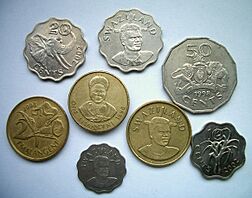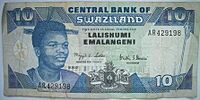Swazi lilangeni facts for kids
Quick facts for kids Swazi lilangeni |
|||
|---|---|---|---|
|
|||
| ISO 4217 Code | SZL | ||
| User(s) | |||
| Inflation | 4.9% | ||
| Source | Central Bank of Swaziland, March 2010 | ||
| Pegged with | South African rand at par | ||
| Subunit | |||
| 1⁄100 | cent | ||
| Symbol | L or E (pl.) | ||
| Plural | emalangeni | ||
| Coins | 10, 20, 50 cents, L1, E2, E5 | ||
| Banknotes | E10, E20, E50, E100, E200 | ||
The lilangeni (plural: emalangeni) is the money used in Eswatini, a country in Southern Africa. It is divided into 100 smaller units called cents. The Central Bank of Eswatini makes and manages this money. The king and his family officially approve it.
You can also use the South African rand in Eswatini. This means both currencies are accepted there. For the lilangeni, people use "L" for one lilangeni (like L1) and "E" for more than one (like E2, E3, or E4).
Contents
History of the Lilangeni
The lilangeni was first used in 1974. It was set up to have the same value as the South African rand. This connection was made through an agreement called the Common Monetary Area. The lilangeni still has the same value as the rand today.
The name lilangeni comes from emaLangeni. This word describes the ancestors of the Swazi people. They moved to the area now known as Eswatini between the 18th and 19th centuries.
Coins of Eswatini
Early Lilangeni Coins
In 1974, Eswatini introduced its first coins. These included values of 1, 2, 5, 10, 20, and 50 cents, plus 1 lilangeni. The 1 and 2 cent coins were made of bronze. The others were made of a metal called cupro-nickel.
Many of these early coins were not round. For example, the 1 and 50 cent coins had 12 sides. The 2 cent coin was square with rounded corners. The 5, 10, and 20 cent coins had wavy edges, like a scallop shell. Only the 1 lilangeni coin was round.
Changes to Coins Over Time
The 2 cent coin was last made in 1982. In 1986, new 1 cent coins (made of copper-plated steel) and 1 lilangeni coins (made of nickel-brass) were introduced. More changes came in 1992. New 5 and 10 cent coins were made of nickel-plated steel. The 1 lilangeni coin was updated to nickel-brass-plated steel.
In 1995, Eswatini introduced new coins with higher values: 2 and 5 emalangeni.
Newer Coin Series
Between 2009 and 2011, another set of new coins came out. These included 5 and 10 cents (copper-plated steel) and 20 cents (nickel-plated steel). A 50 cent coin was also made but not used much. The 1 lilangeni coin was made of brass-plated steel. These new coins were lighter than the older ones because of the different metals used.
In February 2016, a brand new series of coins was released. All the older coins were taken out of use. The new coins look similar but have slightly different sizes and weights. The 10 and 50 cent coins are made of nickel-plated steel. The 1 to 5 emalangeni coins are made of aluminium-bronze. The 1 and 5 cent coins are no longer used.
Banknotes of Eswatini
First Banknotes
On September 6, 1974, the Monetary Authority of Swaziland started printing banknotes. These were for 1 lilangeni, and 2, 5, and 10 emalangeni. In 1978, 20 emalangeni notes were added.
Central Bank Takes Over
In 1981, the Central Bank of Swaziland began making the paper money. They first printed special notes to celebrate the 60th year of King Sobhuza II's rule. From 1982 to 1985, they introduced regular notes for E2, E5, E10, and E20.
In 1990, 50 emalangeni notes were introduced. The E2 and E5 notes were replaced by coins in 1995. Higher value notes, 100 and 200 emalangeni, came out in 1996 and 1998. The E200 notes celebrated 30 years of Eswatini's independence.
Modern Banknotes
On September 5, 2008, the Central Bank of Swaziland issued new 100 and 200 emalangeni notes. These celebrated King Mswati III's 40th birthday and 40 years of independence. On November 1, 2010, the Central Bank released a new series of banknotes. These notes have better security features to prevent fake money.
| Banknotes of the Swazi lilangeni (2010 series) | ||||
|---|---|---|---|---|
| Image | Value | Front Side | Back Side | Special Mark |
| [1] | 10 emalangeni | King Mswati III | Princesses at the Ncwala (a kingship ceremony) | King Mswati III and the number 10 |
| [2] | 20 emalangeni | Flower, corn, and pineapple; a steer (cow); a refinery | King Mswati III and the number 20 | |
| [3] | 50 emalangeni | Central Bank of Swaziland building | King Mswati III and the number 50 | |
| [4] | 100 emalangeni | Elephant, rhinoceros, lion, flowers, and a bird | King Mswati III and the number 100 | |
| [5] | 200 emalangeni | Swazi straw huts; goats; a warrior; a rock formation | King Mswati III and the number 200 | |
| Current SZL exchange rates | |
|---|---|
| From Google Finance: | AUD CAD CHF EUR GBP HKD JPY USD ZAR |
| From Yahoo! Finance: | AUD CAD CHF EUR GBP HKD JPY USD ZAR |
| From XE.com: | AUD CAD CHF EUR GBP HKD JPY USD ZAR |
| From OANDA: | AUD CAD CHF EUR GBP HKD JPY USD ZAR |
| From fxtop.com: | AUD CAD CHF EUR GBP HKD JPY USD ZAR |
See also
- Economy of Swaziland



